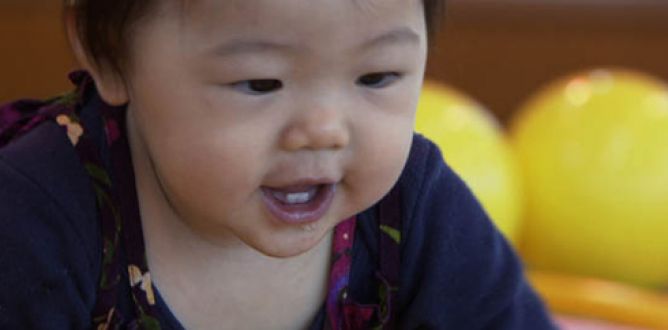Babies Parent Guide
The point of the documentary is not to solicit judgment or charity. Instead it appears to purely exist as a window into the enchanting lives of "Babies".
Parent Movie Review
It’s such a simple idea. Film hours and hours of infants growing and playing during their first year of life, pick the choicest moments, and fill the screen with images sure to leave viewers "ooing and ahhing" for 80 minutes. Welcome to Babies, a French documentary that does exactly what its title suggests.
The filmmakers selected four babies from around the world. In order of introduction is Ponijao, who lives with her family close to Opuwo, Namibia; Bayar, residing with his kin in Mongolia, near Bayanchandmani; Mari whose parents are from Tokyo, Japan; and Hattie, hailing from San Francisco in the United States. We meet each infant at birth or very shortly thereafter. Ponijao is quickly introduced to her natural environment, i.e. the dirt floor of the family hut. Bayar is bound in blankets before taking a motorcycle ride from the hospital to his wilderness home. The urban Japanese and US citizens are placed in car seats and other safety devices.
Living through their first twelve months, they have opportunity to interact with a diversity of objects, animals and situations. For Hattie and Mari, the family cat, as well as outings with mom and dad, make up the bulk of their excitement. (Hattie’s father is especially entertaining after he puts his precious girl on a short slide at the playground, only to have her hit the ground face-first.) Bayar also has a cat in his tented home and interacts with a rooster, goats and cattle kept just outside the door. While no cats are shown in Ponijao’s neighborhood, there is a dog she shares licks with.
Content concerns will vary, depending on your family’s comfort with cultural and maternal nudity. Of course, the babies are often naked, and some of their fathers are shown shirtless. Each of the mothers breastfeeds. And the women and children in Ponijao’s village wear very little clothing at any time (no men are seen). However, this nudity is never sexual. One birth is filmed, but not in explicit detail—we only see the baby moments after he (Bayar) has emerged from his mother.
Quiet and peaceful, and devoid of any narration, Babies unspools without a perceived objective or agenda. The footage certainly proves there is more than one way to raise a child, yet audiences may find their personal societal perspectives challenged. For instance, I had a hard time not gasping as I watched Ponijao rolling around in what must have been feces contaminated soil and sucking water from a pool of dubious quality. Contrasted against the overly protected environments of the city dwellers, I couldn’t help but wonder how an infant could survive in such conditions.
Yet the point of the documentary is not to solicit judgment or charity. Instead it appears to purely exist as a window into the enchanting lives of Babies —those cute little tykes who are even more charming when we aren’t responsible for cleaning up after them.
Directed by Thomas Balmes. Starring Bayar, Ponijao, Hattie, Mari. Running time: 79 minutes. Theatrical release May 7, 2010. Updated July 19, 2016
Babies
Rating & Content Info
Why is Babies rated PG? Babies is rated PG by the MPAA for cultural and maternal nudity throughout.
Cultural and maternal nudity in this documentary includes mothers breastfeeding (with some close-up detail). Namibian woman are frequently shown without any clothing on the top portions of their bodies. Babies are often naked. One male baby urinates while lying on his back. Men are seen without shirts. Some parents may be concerned with children mimicking the things these babies do—like sharing their food with a dog.
Page last updated July 19, 2016
Babies Parents' Guide
The four babies shown in this documentary live in a wide variety of economic conditions. Which babies have access to medical support? Which babies live in reasonably clean conditions? How do our cultures affect what we believe a baby needs to survive? When one country steps in to help another, are they just imposing their values? Or do they have a responsibility to help others have access to medical care and shelter?
What involvement do fathers have in the lives of the babies shown in this film? Which dads do you see most frequently? Which do you see the least? What might be the reasons for this difference?
Home Video
The most recent home video release of Babies movie is September 28, 2010. Here are some details…
Babies releases to DVD and Blu-ray on September 28, 2010.
Related home video titles:
Other babies and children (both human and animal) face the challenges of life in similar locations around the world. Look for the trials of a Mongolian colt and his human caregivers in The Story of the Weeping Camel, the survival of stray birds in San Francisco in The Wild Parrots of Telegraph Hill, the ties that bind a fictional African family in The Gods Must Be Crazy 2 and the sibling relationship captured in the Japanese anime film My Neighbor Totoro.

